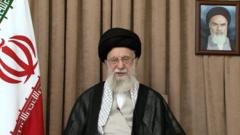Did Iran's Supreme Leader Just Dismiss US Strikes as Futile?

# Understanding the Dynamics of Recent US-Iran Relations Amid Nuclear Tensions
In the complex geopolitical landscape of the Middle East, the recent escalations between the United States and Iran have drawn global attention. Following a series of military strikes on Iranian nuclear facilities and a counter-response from Tehran, the situation has become increasingly tense. This article delves into the intricate details of these developments, the stances taken by key figures like Iran's Supreme Leader Ayatollah Ali Khamenei and US Defense Secretary Pete Hegseth, and the implications for regional stability.
## Background on the Nuclear Tensions
Iran’s nuclear program has been a point of contention for many years, primarily due to concerns over its potential to develop nuclear weapons. The tensions escalated sharply after the US withdrew from the Joint Comprehensive Plan of Action (JCPOA) in 2018, leading to a series of sanctions and military posturing from both sides.
### Key Events Leading to the Current Crisis
1. **US Withdrawal from the JCPOA**: The US exit from the nuclear deal, aimed at limiting Iran’s nuclear ambitions, marked a significant turning point.
2. **Escalating Sanctions**: Following the withdrawal, the US imposed severe sanctions that crippled Iran’s economy, leading to increased hostilities.
3. **Military Strikes**: The recent US strikes on key Iranian nuclear sites, which aimed to disrupt Iran’s capabilities, have heightened fears of a direct military confrontation.
## Key Players and Their Positions
### Ayatollah Ali Khamenei: Iran's Stance
In a recent address, Ayatollah Ali Khamenei declared that the US strikes had not achieved their intended goals. He emphasized that the attacks did not significantly disrupt Iran's nuclear program and threatened further retaliation against US bases if provoked again. Khamenei’s rhetoric reflects a broader strategy of defiance aimed at rallying domestic support and asserting Iran’s sovereignty.
### US Defense Secretary Pete Hegseth: The American Perspective
Contrasting Khamenei’s assertions, Defense Secretary Pete Hegseth characterized the strikes as a “historic success,” claiming they had severely damaged Iran's nuclear capabilities. Hegseth’s position underscores the belief within the US administration that military action can effectively deter Iran’s nuclear ambitions.
## The Aftermath of the Strikes
### Military Repercussions
Following the US strikes on Iran’s nuclear facilities, Khamenei warned that retaliation could occur if the US or its allies continued to threaten Iran. This has raised concerns about a potential escalation into broader conflict in the region.
### Diplomatic Efforts for Ceasefire
Amidst the military actions, President Donald Trump sought to mediate a ceasefire between Iran and Israel. The ceasefire appeared fragile, with sporadic attacks continuing even after the agreement was reached. The tension surrounding these developments highlights the precarious nature of peace in the region.
### Casualties and Humanitarian Impact
The recent conflicts have resulted in significant loss of life, with reports indicating that 610 people were killed during the air attacks, while Israeli authorities reported 28 fatalities. The humanitarian implications of these strikes cannot be overlooked, as civilian populations continue to bear the brunt of military confrontations.
## The Role of International Agencies
The International Atomic Energy Agency (IAEA) has been closely monitoring Iran's nuclear activities. Recent statements from IAEA officials suggest that there may be concerns regarding the potential relocation of Iran's enriched uranium amidst the ongoing conflict. This adds another layer of complexity to the already tense situation.
### Iran's Legislative Actions
In response to the strikes and the perceived threats from the US, Iran’s parliament passed a bill to halt cooperation with the IAEA. This decision signals a shift in Iran’s approach to international oversight and could lead to further isolation from global diplomatic efforts.
## Future Implications for US-Iran Relations
The ongoing tensions between the US and Iran have significant implications for regional stability and international security. As both nations continue to assert their positions, the potential for miscalculation remains high.
### Potential Scenarios
1. **Increased Military Engagement**: If provocations continue, further military strikes could escalate the conflict, leading to broader regional instability.
2. **Diplomatic Negotiations**: A potential return to diplomatic negotiations could ease tensions, but this would require significant concessions from both sides.
3. **Humanitarian Crisis**: Continued conflict could exacerbate the humanitarian situation in the region, leading to a pressing need for international intervention.
## Conclusion: A Call for Caution and Diplomacy
The current state of US-Iran relations is fraught with tension and uncertainty. As both sides navigate this complex web of military action and diplomatic maneuvering, the need for caution and measured responses is paramount. The potential for escalation exists, but so too does the opportunity for dialogue and resolution.
In the pursuit of peace, the international community must advocate for constructive dialogue that prioritizes stability and humanitarian considerations over military escalation. As the situation unfolds, the world watches with bated breath, hoping for a resolution that avoids further conflict.
### FAQs
#### What triggered the recent US strikes on Iran's nuclear facilities?
The strikes were prompted by escalating tensions and concerns over Iran's potential to develop nuclear weapons, particularly after Israel's warnings that Iran could produce a nuclear weapon quickly.
#### How has Iran responded to the US military action?
Iran's Supreme Leader Ayatollah Ali Khamenei has claimed that the US strikes did not achieve their objectives and has threatened further retaliation if Iran is attacked again.
#### What are the potential consequences of the ongoing tensions between the US and Iran?
The ongoing tensions could lead to increased military engagement, a humanitarian crisis, or renewed diplomatic efforts. The situation remains precarious, with risks of miscalculation on both sides.
In light of these developments, how do you see the future of US-Iran relations shaping up? #Iran #USForeignPolicy #NuclearTensions
Published: 2025-06-26 15:46:03 | Category: world



